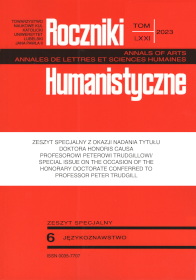500 Years of Past Be in East Anglia: A Variationist Investigation
500 Years of Past Be in East Anglia: A Variationist Investigation
Author(s): Juan Manuel Hernández-Campoy, David BritainSubject(s): Language and Literature Studies, Theoretical Linguistics, Applied Linguistics, Historical Linguistics, Sociolinguistics
Published by: Towarzystwo Naukowe KUL & Katolicki Uniwersytet Lubelski Jana Pawła II
Keywords: historical sociolinguistics; past BE; levelling; language variation and change; Paston Letters; Norwich; East Anglia; Northern Subject Rule; polarity
Summary/Abstract: As it is widely known, the verb to be, in its different tense, person and number forms, is the most frequently used verb in both written and oral English. Additionally, at least in Standard English, it is the most irregular verb, with many different forms. However, this degree of irregularity is not universal across the English-speaking world—more regularised patterns are found in a number of non-standard varieties. Despite much empirical investigation in the variationist literature on past BE, and despite the considerable corpus of work examining East Anglian English, especially by Peter Trudgill (e.g. 2021), there has, as yet, been no variationist investigations of past BE from the core heartland of linguistic East Anglia. In this paper, we try to address this by examining datasets from East Anglia that are half a millennium apart. We begin with a historical sociolinguistic study of past BE forms in the Late Middle English stages of the history of English by observing, detecting, quantifying and analysing their presence in one of the most important linguistic corpora of the period: the Internet electronic edition of the (East Anglian) Paston Letters from the Virginia University Electronic Text Center. We then, much nearer to the present-day, scrutinise a more contemporary corpus of East Anglian English for variable patterns of past BE, namely Peter Trudgill’s own corpus of sociolinguistic interviews from Norwich in the 1960s (see Trudgill, 1974). While the data are (understandably) of very different kinds, our analysis enables us to broaden our understanding of past BE variability, both diachronically and synchronically, by adding East Anglia to the map.
Journal: Roczniki Humanistyczne
- Issue Year: 71/2023
- Issue No: 6S
- Page Range: 103-123
- Page Count: 21
- Language: English

